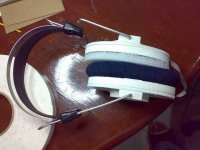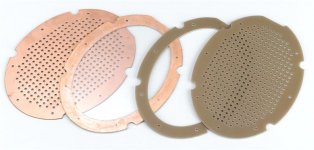Hi Wachara,
Perhaps I'll give a pair off ES-headphones a try later on!
I have had the luck of salvaging an old Roland PNC from the scrap yard - now I just have to learn how to program it!
Realy nice work on you phones and amp!
/R
Perhaps I'll give a pair off ES-headphones a try later on!
I have had the luck of salvaging an old Roland PNC from the scrap yard - now I just have to learn how to program it!
Realy nice work on you phones and amp!
/R
I've looked at that article a few times on Headwize and your version looks very
professional.
A note on the bass response...
It looks as if you are using some kind of felt to cover your ear pads. I would strongly suggest
using leather or pleather (fake leather) as it creates a better seal with your head. I have experimented quite a bit with headphones(dynamic, orthodynamic, electrostatic) and switching earpad materials has a profound impact on the sound. Stax uses leather on all of their ear pads
and I suspect it is for this reason.
Good luck!
professional.
A note on the bass response...
It looks as if you are using some kind of felt to cover your ear pads. I would strongly suggest
using leather or pleather (fake leather) as it creates a better seal with your head. I have experimented quite a bit with headphones(dynamic, orthodynamic, electrostatic) and switching earpad materials has a profound impact on the sound. Stax uses leather on all of their ear pads
and I suspect it is for this reason.
Good luck!
vaughn said:I've looked at that article a few times on Headwize and your version looks very
professional.
A note on the bass response...
It looks as if you are using some kind of felt to cover your ear pads. I would strongly suggest
using leather or pleather (fake leather) as it creates a better seal with your head. I have experimented quite a bit with headphones(dynamic, orthodynamic, electrostatic) and switching earpad materials has a profound impact on the sound. Stax uses leather on all of their ear pads
and I suspect it is for this reason.
Good luck!
Dear Vaughn,
I have nothing to complain about the bass response. I love it. It is far better than other headphones that I have.
About the ear pads, I use insulation material which I find from the left over around my house. It is like a plastic sponge. Although it doesn't feel as comfortable as the real sponge, I find it to be acceptable. I cover it with plain cloth. Yes, I think leather should be good for this application. However, it is quite difficult for me to source for it.
I really think that the diaphragm material makes a lot of difference. I have bought a small amount of 1.5 microns and 0.9 microns mylar, and they should arrive very soon. I will try them out and let you know how much difference they make.
Wachara C.
Attachments
Hi
Very good job !
20 years ago I made an ES heaphone for the french magazine "L'Audiophile".
I use 700 volts polarizing voltage to the diaphragm and spacing between diaphragm and electrode is 0.7 mm gives 10 kV/cm electric field.
Here's are some pictures:
Philippe
Very good job !
20 years ago I made an ES heaphone for the french magazine "L'Audiophile".
I use 700 volts polarizing voltage to the diaphragm and spacing between diaphragm and electrode is 0.7 mm gives 10 kV/cm electric field.
Here's are some pictures:
Philippe
Hi Phillips,
Can you check? I can't see your pictures.
My spacer thickness is 1 mm. The bias voltage is selectable between 600V and 900V. For most of the time, 600V is sufficient.
Wachara C.
Can you check? I can't see your pictures.
My spacer thickness is 1 mm. The bias voltage is selectable between 600V and 900V. For most of the time, 600V is sufficient.
Wachara C.
Yes, I am curious as well to see these pictures!
Between this and the developing DIY Electrostatic energizer(tube) developing on Head-Fi
I am becoming inspired to build my own set from the ground up.
I loved my Stax set but I couldn't ever justify owning a $1200 pair of headphones and ended up
selling them.
Between this and the developing DIY Electrostatic energizer(tube) developing on Head-Fi
I am becoming inspired to build my own set from the ground up.
I loved my Stax set but I couldn't ever justify owning a $1200 pair of headphones and ended up
selling them.
More pictures :
My electrostatic headphone construction :
The two "Cale d'espacement" are gaskets which give spacing between the diaphragm and the two electrodes.
Before mounting :
Diaphragm is on the left part. Connection to the copper side of electrode use a sort of metallized hole.
Philippe
My electrostatic headphone construction :
An externally hosted image should be here but it was not working when we last tested it.
The two "Cale d'espacement" are gaskets which give spacing between the diaphragm and the two electrodes.
Before mounting :
An externally hosted image should be here but it was not working when we last tested it.
Diaphragm is on the left part. Connection to the copper side of electrode use a sort of metallized hole.
Philippe
Hi Phillipe,
Your stator has a lot more open area than mine. Do you think that more open area is better?
Have you tried using it with a direct driven headphone amp?
Wachara C.
Your stator has a lot more open area than mine. Do you think that more open area is better?
Have you tried using it with a direct driven headphone amp?
Wachara C.
Hello Wachara,
A lot of questions !
A greater open area gives a better frequency response (at my mind !), but performance depends on a lot of factors.
I also made several direct drive amplifiers with 6CG7/6FQ7 or EL34 output tubes and other ES headphones but unfortunately L'Audiophile magazine disappeared in 1995.
I used 3,5 µm thickness "Terphane" for the active and the passive diaphragms. Terphane is DuPont de Nemours's Mylar made under license by Rhone-Poulenc. My Terphane is a D type especially designed to make Mylar condensers. The passive, not stretched, diaphragm protects the active diaphragm from ear moisture. I used this technique from Stax.
I made a special machine for stretching and sticking the active diaphragm on its support. The machine uses pliers, pulleys, lead weights and strings. The diaphragm is stretched with precision to compensate electrostatic forces on the diaphragm then frequency response and efficiency are the same for all diaphragms. Silkscreen printing technique is used to apply epoxy glue on the diaphragm frame (support de diaphragme) and the other parts.
Philippe
A lot of questions !
A greater open area gives a better frequency response (at my mind !), but performance depends on a lot of factors.
I also made several direct drive amplifiers with 6CG7/6FQ7 or EL34 output tubes and other ES headphones but unfortunately L'Audiophile magazine disappeared in 1995.

I used 3,5 µm thickness "Terphane" for the active and the passive diaphragms. Terphane is DuPont de Nemours's Mylar made under license by Rhone-Poulenc. My Terphane is a D type especially designed to make Mylar condensers. The passive, not stretched, diaphragm protects the active diaphragm from ear moisture. I used this technique from Stax.
I made a special machine for stretching and sticking the active diaphragm on its support. The machine uses pliers, pulleys, lead weights and strings. The diaphragm is stretched with precision to compensate electrostatic forces on the diaphragm then frequency response and efficiency are the same for all diaphragms. Silkscreen printing technique is used to apply epoxy glue on the diaphragm frame (support de diaphragme) and the other parts.
Philippe
Hi Phillipe,
Thank you very much for your kind replies. I'm sure many of us here will benefit from your techniques.
About the amp you built, would you be so kind to share with us? I made mine from the design from www.tubecad.com . I make a complete diagram as follow:
I strongly recommend those who want to build an ES headphone also build a set of direct-drive amp. It sounds so much better as compare to using transformer.
Wachara C.
Thank you very much for your kind replies. I'm sure many of us here will benefit from your techniques.
About the amp you built, would you be so kind to share with us? I made mine from the design from www.tubecad.com . I make a complete diagram as follow:
An externally hosted image should be here but it was not working when we last tested it.
I strongly recommend those who want to build an ES headphone also build a set of direct-drive amp. It sounds so much better as compare to using transformer.
Wachara C.
Sorry, I have some problems with attached files ! 😕
I think your amplifier design is good. Schmitt type phase splitter with high value common cathode resistor and negative supply gives signals of equal amplitudes.
For "L'audiophile" magazine I used the "A circuit", slightly modified, from Stax. I think this is the first direct-drive amplifier for electrostatic headphones (end of the 60's !). It's appears in the Funya site : http://wiki.livedoor.jp/funya2420/d/6FQ7
Philippe
🙂
I think your amplifier design is good. Schmitt type phase splitter with high value common cathode resistor and negative supply gives signals of equal amplitudes.
For "L'audiophile" magazine I used the "A circuit", slightly modified, from Stax. I think this is the first direct-drive amplifier for electrostatic headphones (end of the 60's !). It's appears in the Funya site : http://wiki.livedoor.jp/funya2420/d/6FQ7
Philippe
🙂
Post "edit" function doesn't work 😕 read "B circuit" instead of "A circuit" for Stax ES amplifier.
The Stax "A circuit" :
The Stax "B circuit" :
I used this "B circuit" in my article "Un amplificateur pour casque électrostatique" in L'Audiophile ; May 1990 :
Philippe
The Stax "A circuit" :
An externally hosted image should be here but it was not working when we last tested it.
The Stax "B circuit" :
An externally hosted image should be here but it was not working when we last tested it.
I used this "B circuit" in my article "Un amplificateur pour casque électrostatique" in L'Audiophile ; May 1990 :
An externally hosted image should be here but it was not working when we last tested it.
Philippe
Thank you, Wachara !
Home-made machine used to stretch the diaphragm :
Philippe
🙂
Home-made machine used to stretch the diaphragm :
An externally hosted image should be here but it was not working when we last tested it.
Philippe
🙂
Here is another picture of my amp.
An externally hosted image should be here but it was not working when we last tested it.
- Home
- Amplifiers
- Headphone Systems
- Has anybody made an ELS headphone?

